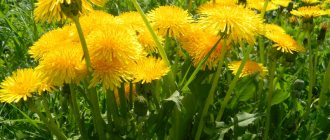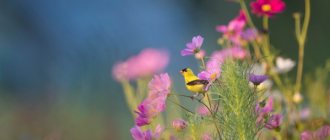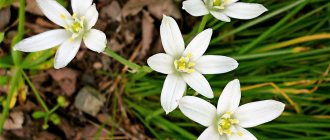Description
Bridal bush grows best in warm climates. That is, on the territory of our country, for the most part, southern regions are suitable for its cultivation. Even in the middle zone, the plant is not very common due to its heat-loving nature. But starting around Tambov and further south, gardeners cultivate spurge with great pleasure.
Euphorbia is famous for its rapid growth: from the moment of planting to the appearance of a lush, bushy plant, only a few months pass. Euphorbia looks gorgeous in the garden, representing a real decoration of the surrounding landscape.
Since the plant easily reproduces in favorable conditions by self-sowing, it is able to “occupy” all nearby free territories in a short time. If you are not too happy with this garden design option, you will have to remove the seed pods on time.
Photo of heat-loving spring garden flower balsam
Garden balsam, Vanya wet or impatiens balsamina (Impatiens balsamina) is one of the most popular and beloved plants by gardeners.
Unpretentious and long-blooming, with the richness and variety of colors of its flowers, it will be a worthy competitor to any exotics. Terry balsam and another equally decorative variety of two-color balsam will look luxurious in any mixborder.
Terry variety of balsam
Two-color balsam - decoration for any flower bed
The plant loves heat very much and can suffer from the slightest drop in temperature. Tall, fleshy and brittle stems of balsam, dotted with flowers and lanceolate leaves, are often used to create dominant groups in mixborders. The flower is called wet Roly because of the sugar droplets on the cloves of the leaves. And they began to call it touchy, because at the slightest touch to a plant with ripe fruit capsules, the seeds are scattered over considerable distances.
External characteristics
There are many varieties of milkweed, but only one of the species is called a bride - fringed milkweed. This species boasts small but multiple buds located at the very top of the shoots. The buds also have a white tint, however, the bush was not nicknamed the bride because of them. The unusual name is associated with foliage with a white border (see photo). It is interesting that at the beginning of their growth the leaves are evenly green; they acquire a white edge later.
The shrub is small in height, reaching only 80-90 cm. However, it grows very lush. The leaves are 6-8 cm long, the stems branch well. The buds and foliage of the plant are not at all afraid of the sun, do not lose their decorative value, and do not fade even in severe drought. Euphorbia blooms from July until the first autumn frosts.
Application
In landscape design, spurge is highly valued. With the help of this light plant you can make remote corners of the garden more attractive and elegant. Due to the peculiar white color of the bush, it is possible to achieve a visual expansion of the space.
In group plantings, euphorbia is usually used to separate those plants whose colors do not combine well with each other. Euphorbia itself in this regard has a rare versatility, but its variegated foliage looks especially impressive against the backdrop of red and blue flowers: roses, delphiniums.
Use in landscape design
The shrub of ideal beauty is very popular in landscape design. It can act as a hedge or as a single decoration; its combination with coniferous plants is possible and recommended. Often the shrub is planted for decoration near the shores of reservoirs or combined with planting against the background of a lawn with other varieties of spirea with all sorts of shades of colors during flowering.
To visually design lawns or landscape areas, it is necessary to understand the timing of flowering
All spirea are divided into two groups:
- spring-flowering - most often varieties with white petals bloom on last year's shoots;
- summer-flowering - in most cases, varieties with bright flowers are found on the shoots of the current year.
This plant does not respond to air and soil pollution factors, so its planting is common for the purpose of landscaping factory and industrial areas.
Important! The “White Bride” shrub can be cut off and given any decorative shape, but in this case its flowering will stop.
Growing conditions
Let's find out where to plant spurge on the site, what conditions the plant needs for normal growth.
Location and lighting
Euphorbia should be planted in an area well lit by the sun. Garden spurge cannot tolerate shade and loses all its beauty and attractiveness in such conditions. If you plant a plant on the shady side of the site, the bush will not die immediately, of course, but it will turn out to be inconspicuous, low, and its leaves will be deprived of a white border. The lifespan of the flower will be significantly reduced.
Temperature and humidity
“Bride” is able to tolerate even severe drought and adequately perceives direct sunlight. But the plant does not like cold weather, which is why growing milkweed in the northern regions is problematic.
Humidity levels should be kept moderate. The shrub does not need too frequent watering and is afraid of prolonged rains.
Soil composition
It is better for milkweed to grow in dry, loose soil. Clayey, dense soil is not suitable. The soil should be fertile, but in moderation: the plant categorically does not tolerate excess minerals, especially nitrogen.
Light
Although the bride flower does not need direct sunlight, the campanula still requires good lighting. It is highly desirable that some of the sun's rays constantly fall on the leaves. We often hang pots with bells above the window: in this case, the plant is illuminated not by direct rays (covered by the cornice and frame), but by reflected light. This should ensure dense growth and abundant flowering.
Isophylla can bloom well even on the sunny side, but only if the pots are on the windowsill and not in the shade. Bride is a long-day plant and requires about 15 hours of daylight before flowering. In this case, the buds will develop correctly. Additional artificial light may cause flowers to bloom earlier than usual.
How to care
Let's find out what kind of care garden milkweed needs.
Watering
Frequent soil wetting is not recommended in this case. Euphorbia does not tolerate stagnation of water in the soil and reacts to this fact by rotting the roots. Water moderately and preferably in the evening.
Feeding
The plant responds well to mineral fertilizers and also responds well to organic matter. The only caveat is that excessive application of nitrogen should be avoided.
Usually, after feeding, the plant shows a rapid leap in development and growth. Experienced gardeners recommend using a fertilizer with natural ingredients called “Lignohumate” for euphorbia.
Garter
The perennial shrub grows strongly, often its shoots sag and fall to the ground under the weight of foliage and buds. To prevent this from happening, shoots should be tied to a support.
Trimming
Euphorbia shoots are cut off before wintering. The procedure should be carried out in late autumn.
Diseases and pests
Due to the fact that poisonous milky sap flows in the “veins” of the plant, it is not affected by pests. Euphorbia is also resistant to diseases, but does not like waterlogging and does not tolerate nitrogen.
Temperature
Since flowers quickly fade in extreme heat, they should be placed indoors in the coolest place (relevant for the summer). At temperatures above 18 °C, campanula provide high humidity by placing plants on trays with moistened pebbles or near a humidifier, remembering to spray regularly. This will help significantly extend the flowering period.
In winter, these plants should rest at very cool temperatures - ideally around 4°C and certainly not above 10°C. Warmer temperatures in winter help shorten the next flowering season. For optimal bud formation, drafts should be avoided.
Features of reproduction
Euphorbia, when grown in the garden, can be propagated in two ways: seeds and cuttings. Let's take a closer look at both options.
Cuttings
This method is rarely used when growing milkweed, since it is more complex than the seed method. But if you still decide to take cuttings, get acquainted with the algorithm of the procedure.
- A cutting is cut that has at least one high-quality, developed bud.
- The shoot is placed in a glass of water so that the milky juice comes out of the cut. As long as the milky sap covers the cut, roots will not be able to appear.
- After the water procedure, the cuttings are dried by placing them in a dark and cool room.
- When the shoot dries, it is planted in a nutrient substrate in the open ground. Before rooting, it is better to protect the cuttings from adverse weather conditions with a cut plastic bottle on top.
Seeds
Euphorbia itself is capable of reproducing by seeds perfectly and without outside help. In a short time, this plant can fill all the nearby free space: if you are satisfied with this state of affairs, you won’t even have to help the shrub reproduce.
But if you want to approach seed propagation responsibly and create cultural plantings, use the following algorithm.
- Seeds are sown for seedlings in March; the soil should be moderately moist, nutritious and fairly loose. Euphorbia seeds do not need preliminary stratification.
- Before germination, the container must be insulated on top with film; after germination of the seeds, the cover must be removed. The first shoots should be expected approximately a couple of weeks after planting.
- If the seeds were planted in a common container, pick the sprouts at the stage of formation of the third or fourth leaf.
- When the threat of return frosts has passed, the seedlings are placed in open ground on a previously prepared bed. Depending on the climate of the region, planting outside is carried out from mid-April to the end of May.
How to grow the perennial flower "Rich Bride" in the garden
The “bride” or “rich bride” flower is known in the scientific world as milkweed or euphorbia. The flower earned its popular name due to the unusual white color of its lush foliage. In this article we will look at the features of growing milkweed on the site and get acquainted with the nuances of caring for this plant.
Description
Bridal bush grows best in warm climates. That is, on the territory of our country, for the most part, southern regions are suitable for its cultivation. Even in the middle zone, the plant is not very common due to its heat-loving nature. But starting around Tambov and further south, gardeners cultivate spurge with great pleasure.
Euphorbia is famous for its rapid growth: from the moment of planting to the appearance of a lush, bushy plant, only a few months pass. Euphorbia looks gorgeous in the garden, representing a real decoration of the surrounding landscape.
Since the plant easily reproduces in favorable conditions by self-sowing, it is able to “occupy” all nearby free territories in a short time. If you are not too happy with this garden design option, you will have to remove the seed pods on time.
External characteristics
There are many varieties of milkweed, but only one of the species is called a bride - fringed milkweed. This species boasts small but multiple buds located at the very top of the shoots. The buds also have a white tint, however, the bush was not nicknamed the bride because of them. The unusual name is associated with foliage with a white border (see photo). It is interesting that at the beginning of their growth the leaves are evenly green; they acquire a white edge later.
The shrub is small in height, reaching only 80-90 cm. However, it grows very lush. The leaves are 6-8 cm long, the stems branch well. The buds and foliage of the plant are not at all afraid of the sun, do not lose their decorative value, and do not fade even in severe drought. Euphorbia blooms from July until the first autumn frosts.
Application
In landscape design, spurge is highly valued. With the help of this light plant you can make remote corners of the garden more attractive and elegant. Due to the peculiar white color of the bush, it is possible to achieve a visual expansion of the space.
In group plantings, euphorbia is usually used to separate those plants whose colors do not combine well with each other. Euphorbia itself in this regard has a rare versatility, but its variegated foliage looks especially impressive against the backdrop of red and blue flowers: roses, delphiniums.
Growing conditions
Let's find out where to plant spurge on the site, what conditions the plant needs for normal growth.
Location and lighting
Euphorbia should be planted in an area well lit by the sun. Garden spurge cannot tolerate shade and loses all its beauty and attractiveness in such conditions. If you plant a plant on the shady side of the site, the bush will not die immediately, of course, but it will turn out to be inconspicuous, low, and its leaves will be deprived of a white border. The lifespan of the flower will be significantly reduced.
Temperature and humidity
“Bride” is able to tolerate even severe drought and adequately perceives direct sunlight. But the plant does not like cold weather, which is why growing milkweed in the northern regions is problematic.
Humidity levels should be kept moderate. The shrub does not need too frequent watering and is afraid of prolonged rains.
Soil composition
It is better for milkweed to grow in dry, loose soil. Clayey, dense soil is not suitable. The soil should be fertile, but in moderation: the plant categorically does not tolerate excess minerals, especially nitrogen.
How to care
Let's find out what kind of care garden milkweed needs.
Watering
Frequent soil wetting is not recommended in this case. Euphorbia does not tolerate stagnation of water in the soil and reacts to this fact by rotting the roots. Water moderately and preferably in the evening.
Feeding
The plant responds well to mineral fertilizers and also responds well to organic matter. The only caveat is that excessive application of nitrogen should be avoided.
Usually, after feeding, the plant shows a rapid leap in development and growth. Experienced gardeners recommend using a fertilizer with natural ingredients called “Lignohumate” for euphorbia.
Garter
The perennial shrub grows strongly, often its shoots sag and fall to the ground under the weight of foliage and buds. To prevent this from happening, shoots should be tied to a support.
Trimming
Euphorbia shoots are cut off before wintering. The procedure should be carried out in late autumn.
Diseases and pests
Due to the fact that poisonous milky sap flows in the “veins” of the plant, it is not affected by pests. Euphorbia is also resistant to diseases, but does not like waterlogging and does not tolerate nitrogen.
Features of reproduction
Euphorbia, when grown in the garden, can be propagated in two ways: seeds and cuttings. Let's take a closer look at both options.
Cuttings
This method is rarely used when growing milkweed, since it is more complex than the seed method. But if you still decide to take cuttings, get acquainted with the algorithm of the procedure.
- A cutting is cut that has at least one high-quality, developed bud.
- The shoot is placed in a glass of water so that the milky juice comes out of the cut. As long as the milky sap covers the cut, roots will not be able to appear.
- After the water procedure, the cuttings are dried by placing them in a dark and cool room.
- When the shoot dries, it is planted in a nutrient substrate in the open ground. Before rooting, it is better to protect the cuttings from adverse weather conditions with a cut plastic bottle on top.
Seeds
Euphorbia itself is capable of reproducing by seeds perfectly and without outside help. In a short time, this plant can fill all the nearby free space: if you are satisfied with this state of affairs, you won’t even have to help the shrub reproduce.
But if you want to approach seed propagation responsibly and create cultural plantings, use the following algorithm.
- Seeds are sown for seedlings in March; the soil should be moderately moist, nutritious and fairly loose. Euphorbia seeds do not need preliminary stratification.
- Before germination, the container must be insulated on top with film; after germination of the seeds, the cover must be removed. The first shoots should be expected approximately a couple of weeks after planting.
- If the seeds were planted in a common container, pick the sprouts at the stage of formation of the third or fourth leaf.
- When the threat of return frosts has passed, the seedlings are placed in open ground on a previously prepared bed. Depending on the climate of the region, planting outside is carried out from mid-April to the end of May.
Important: if you plant several specimens, leave a distance of 30 cm or more between them. Do not forget that the bush in adulthood becomes very spreading and voluminous.
You can plant seeds before winter, directly in open ground. Thus, during the winter, natural stratification of the seeds will occur, and in the spring the strongest and hardened ones will germinate safely.
We got acquainted with a unique plant, known to scientists as euphorbia or milkweed, and popularly known as the “rich bride.” There is nothing difficult in growing an unpretentious shrub: the main thing is to protect it from excess moisture and not to overdo it with nitrogenous fertilizing. Euphorbia will thank you for your care with lush flowering and will delight you with its beauty throughout the summer.
How to plant a flower for the bride and groom. Houseplant care
Lovers of indoor plants will appreciate the neat and beautiful flower called campanula or bellflower. Paired flowers of different varieties are usually planted in one pot - with snow-white and blue flowers, as in the photo. For this, the people called them the bride and groom. Simple care of the plant will help preserve its decorative appearance for a long time.
Bride and Groom: origin of the name
The “bride and groom” flower are different types of bellflower, or campanula. It received such a beautiful and romantic name because of its delicate flowers with innocent white, bright blue, lilac buds, which are so similar to bells and are associated with a young couple of lovers.
Varieties of Campanula white and blue
Campanula bride and groom belongs to plants from the Campanula genus, Campanula family. The Mediterranean is considered the birthplace of this flower. A popular indoor plant has the following names: “bride and groom”, indoor bell, “falling stars”.
Two types of campanula in one pot
This is the only type of bell that is grown as a houseplant. The bell with snow-white buds belongs to the Alba (bride) variety, and with blue ones - to the Maya (groom) variety. This is what people believe: the bride’s campanula is a white flower, and the groom’s campanula is a blue flower. Very often they are planted in one pot, thereby creating an incredibly beautiful composition.
Description and characteristics of the flower bride
Campanula has many varieties, but only one is grown indoors - Campanula equifolia. It belongs to the herbaceous flowering perennials. Bride characteristics:
- stems - thin, creeping, up to 25 cm long;
- The leaves are small, heart-shaped, rounded, with long petioles. Placed on the shoot alternately;
- The flowers are bell-shaped, up to 4 cm in diameter, and consist of 5 petals. Collected in 2-4 pieces. at the end of the stem.
Attention! The bride's bloom continues all summer long.
Many are sure that the same bush blooms with different colors. In fact, to achieve this effect, a couple of different varieties are planted in one container. Those same “groom” with blue flowers and white “bride” are varieties called Mayi and Alba. There are also varieties with purple and pink flowers.
It is popularly believed that the bride flower improves the energy of the home, cleanses the atmosphere, and helps in stressful situations. Nowadays it is not so easy to find a shoot of this plant for planting. Although 10-20 years ago, indoor campanula was very popular. Today, she is undeservedly in oblivion.
Description of the bride plant
The indoor Bride flower is a small herbaceous plant. It is distinguished by creeping and hanging shoots, abundantly dotted with white or blue flowers, clearly reminiscent of a star in shape. Moreover, resourceful flower growers, having christened the plant with white flowers the Bride, named its blue counterpart the Groom. At the same time, the indoor flowers of the Bride and Groom are often planted in the same container. (Indoor flower Bride and Groom photo).
The leaves of Campanula rest on long thin petioles, are light green in color and have a rounded heart-shaped shape with teeth along the edges. Flowers collected in clusters reach 4 centimeters in diameter. The period of intense flowering lasts from the beginning of June to the end of October.
Campanula is a perennial plant, therefore, with proper care, Bride and Groom indoor flowers can delight the owner with the beauty of their bright petals for several years.
The indoor Bride flower has shoots of a soft green color. During summer flowering, they are covered with an abundant scattering of small flowers. To extend the flowering period, you need to carefully remove dried buds.
Planting the bride at home
The technique depends on the method you choose. There are 2 of them, and both are quite effective:
- Seeds. The work is carried out in the spring using purchased seed.
- Cuttings. This method is usually used to renew an aged plant.
Attention! In both cases, at first keep the containers under a transparent cap or film.
Seeds and cuttings need to be regularly watered and sometimes ventilated. The substrate for campanula should be loose and well aerated. A universal mixture from the store will do. An alternative is a mixture of equal parts of leaf soil, crushed peat, humus and sand. It is useful to add a little charcoal to such soil.
Attention! The plant consumes a lot of water. Therefore, even at this stage it is important to take care of high-quality drainage in the pot.
The bride and groom flower has a well-developed powerful root system. It lies below the surface, but it expands greatly. The plant needs an appropriate pot: wide, but not deep.
The bride does not like shadows or strong lighting. In the first case, it will be underdeveloped and pale, the shoots will grow long and weak, and under the bright sun the leaves of the plant will curl and dry out. Choose the middle option for it: a western or, even better, an eastern window.
Attention! Experts recommend placing the bride on a stand by the window or hanging it in a flowerpot instead of a window sill. This can be successfully used in decorative terms.
Purchasing a plant
Before you begin implementing our recommendations, you need to purchase the plant itself. You can buy it in stores by browsing the flower departments. I must say, he is not a very frequent visitor to such places. But if you are lucky, you will become the happy owner (or possessor) of this green pet.
The second purchasing option is to buy from grandmothers. Ask around, maybe someone will agree to sell you a young plant.
Checking roots
If the root system looks pretty good externally, do not rush to replant the beauty. Firstly, she needs to undergo acclimatization in your apartment or house. This is a stressful situation, and if you add to it a replanting with freeing the roots from the soil, it will not be difficult to destroy the flower.
Dilute the drug “Fitosporin” in water. The color of the concentrate should resemble strong black tea. From this concentrate, prepare a solution for irrigation: 15 drops per liter of irrigation water. Spray the plant with Fitosporin. This needs to be done as soon as you arrive home and look at the roots. “Fitosporin” will destroy fungi and spores that contribute to the spread of root and other rot.
Pest treatment
Now let's examine the green mass of the plant. Often unexpected guests “come” to us from the store - all kinds of pests that attack leaves and flowers. If light spots are noticeable or something else bothers you about the general appearance of the plant, treatment is needed. You can use “Fitoverm” or “Intavir”. Dilute the drug according to the instructions and treat the above-ground part of the plant. By the way, you can also water the ground if the soil allows it.
Trimming shrunken parts
We can say that your indoor flower “bride” has been saved. How to care next? Remove any blooms on the plant. Carefully cut off damaged leaves and broken stems with sharp scissors. Now your “bride” is almost ready for the next step of post-purchase processing.
Campanula transplant
A newly purchased campanula should not be disturbed for several days, during which time it must adapt to new conditions. After this, it must be transplanted. To do this, use a wide pot, at the bottom of which a good drainage layer is made. A suitable soil mixture must be loose, its composition: peat, humus, coarse sand and leaf soil (1: 1: 1: 1).
Next, the bush is replanted in the spring at the very beginning of active growth. But experienced flower growers advise not to replant the old bush, but to grow a new flower from cuttings in the spring.
Source
Features of flower care for the bride
Like many indoor plants, the bellflower has periods of activity and dormancy throughout the year. The second occurs gradually after the end of rich summer flowering. The bride reacts to the decrease in light and drop in temperature. Old shoots turn yellow and leaves die. At this time, it is important to properly prepare the crop for wintering. Trim the shoots to 2 inches above the ground to help the plant send out young stems in the spring, which will be the focus of new blooms.
Attention! The lifespan of an indoor bell is 1-2 seasons. Most often, after the second flowering, the plant weakens and dies completely. The owners prolong its life by rooting cuttings.
The bride needs to be provided with adequate conditions similar to her natural habitat - the rocks of the Mediterranean:
- Abundant watering. The soil should always be moist. In moderate heat, you can water the flower once every 2-3 days, in hot summer - every morning. Consider the capabilities of the drainage system. Too much water can cause the soil to become soggy. The bride is not picky about the composition of the liquid. You can even get it from the tap.
- The temperature for normal development of the crop is +23…+25 °C in summer and about +13 °C in winter.
Attention! The bride needs moisture even during the rest period, but in smaller quantities - once a week.
Basics of cultivation and care
How to care for an indoor bride flower at home so that it is always in great shape:
Choosing a place in the house and lighting
To prevent the bride and groom's indoor flowers from wilting, they should not be placed in places with direct sunlight. The north side of the apartment is not suitable for bells. The best option for placing the flower would be a well-lit window sill, preferably near an east or west window. By placing a pot with a flower on the south side of the apartment, you can provoke the wilting of the leaves of the campanula. If all the windows of the apartment face north, then it is necessary to provide the flower with additional round-the-clock lighting.
Many types of bluebell in pots on the table
In the summer, when the weather is good outside, the bride can be taken out onto the balcony or terrace. During heavy rain or wind, she must be taken back to the apartment. With the arrival of autumn, the campanula must be returned to indoor maintenance again.
Important! During the midday heat, the plant needs to be shaded or moved to a cool place.
Temperature
The indoor bride flower tolerates small changes in room temperature well. Even if it is cool on the windowsill in winter (around + 14-16 °C), such a microclimate is perfect for this delicate plant. With the arrival of spring and summer, a temperature of about + 25-26°C will be more suitable for it.
When heating radiators heat the window sills in winter, the soil moisture in the pot decreases greatly; it is better to place the bride in a hanging pot or move it to another place, for example, on a refrigerator, bedside table or table near the window.
Choosing a pot
With the arrival of spring, the plant must be transplanted into a new pot, since over the year the soil in the old pot has become very depleted and has lost its nutritional qualities. In early March, the indoor groom or bride flower must be transplanted into new soil rich in useful components.
Flower pot with bride
An overgrown plant needs a new spacious pot so that the roots do not suffer due to cramped space. After transplanting or planting, the plant goes through an adaptation period, so it should be removed away from bright sunlight and not fertilized for one week.
Soil preparation
Universal soil for decorative flowering plants can be purchased at a flower shop. You can also cook it yourself. To do this, you will need coarse river sand, turf, dry humus, compost and leaf soil. All components are taken in equal parts. After planting, it is very important to periodically loosen the soil in the flower pot, since the plant needs oxygen, which promotes the active development and flowering of the campanula.
Additional Information. The soil for growing campanula should be light and easy to loosen. Regular black soil is too heavy for such a delicate flower.
Watering and humidity
Campanula is not a moisture-loving plant, so in winter it should be watered no more than once every two weeks. Water for irrigation should be used only purified or well-settled. In summer, especially when it is very hot, campanula needs timely, good watering. This should be done as soon as the top layer of soil dries. It is also necessary to periodically spray the bride; this will have a good effect on her development, despite the fact that she tolerates dry air quite well.
Curvy bride with green leaves
Active sunlight, too wet or dry soil are the worst enemies of the plant. You need to water the bride very carefully, trying not to get on the delicate petals and flowers. It is important to ensure that there is not too much water. For irrigation, you can use water with wood ash diluted in it - this will have a good effect on the growth of the flower and make the leaves more saturated in color. The humidity in the room where the bride is standing should be at least 40%. To humidify the room you need to use a spray bottle or humidifier.
Note! When watering, it is important not to overdo it with the amount of water, otherwise rotting of the root system will not be avoided.
Top dressing
The use of beneficial vitamins and minerals will help ensure good and proper growth of the plant, as well as give it additional strength and stimulate the immune system, as a result it will get sick less.
During the period of active growing season and abundant flowering, which occurs in March-August, it is worth applying fertilizing with universal complexes every 14-25 days. In the winter season, there is no need to feed the bride, since the plant is in a dormant period.
Trimming
In order to ensure long flowering of the campanula throughout the growing season, it is necessary to promptly remove all faded bells. With the arrival of autumn, when the plant begins to prepare for winter rest, you need to cut off all dry, damaged and elongated stems.
Such an amazing indoor flower as the “bride and groom” can become a decoration for any interior. This delightful plant will delight the eye with its delicate flowers and bring a positive mood.
Reproduction of ornamental plants
The owners of the flower, the bride and groom, regularly face the need to reproduce it. This can be done at home using cuttings. In the spring, select and cut off young healthy branches 10 cm long from the plant. Place them in water for a while and wait for the roots to appear or treat them with Kornevin. Flower growers advise planting several cuttings at once in one pot. After this, the soil should be spilled with phytosporin, and the container itself should be covered with film (the optimal temperature inside is about +13 ° C).
Advice. When it reaches 12 cm, pinch the cutting. This way you will stimulate the side shoots, and the greenery will turn out more luxuriant.
Water and ventilate the bride. After about 20-25 days, the greenhouse can be dismantled and the pot sent to the windowsill. The bride is also propagated by dividing the bush. At the last stage of flowering, cut off all the greenery at the root and wait for green shoots to appear. After this, the bell can be divided.
Gardeners successfully grow campanula indoors. The bride needs simple care, plenty of water and normal lighting. In addition, do not forget to remove dead greenery and faded buds from time to time to maintain the decorative appearance of the flower throughout the season.
Campanula propagation methods
groom bride
The indoor flower “Bride and Groom” is propagated at home in several ways:
- Dividing the bush.
- By cuttings.
- Young shoots.
Reproduction by dividing the bush
When transplanting an overgrown plant, it can be divided into several divisions. To do this, carefully remove the bush along with the earthen lump from the pot and use a knife to divide it into parts. The cutting areas are treated with crushed charcoal, and the cuttings are planted in new planting containers. It is not recommended to deeply bury them in the soil mixture. The planted new bushes are watered with water at room temperature, and for the first time they are placed in a shaded place.
Cuttings
Cuttings can be obtained after pruning. For rooting, only sections from the bottom of the shoots are used. Rooting occurs in containers filled with peat-sand mixture.
Caring for cuttings consists of spraying soil around them and maintaining the room temperature within +20-+25C. When the segments take root and grow to a height of 10 cm, pinching is necessary. This will provoke the growth of side shoots.
If the cuttings were planted in spring or summer, then by autumn they will grow a little, and in autumn and winter they will rest. In the spring, Campanula propagated from cuttings can bloom with proper care.
Reproduction by young shoots
In spring, young shoots appear on the plant, which can be separated, rooted and planted as a separate campanula bush. To do this you need:
- Separate a young shoot 10-20 cm long along with the “heel”.
- Plant in the soil mixture, water with “Fitosporin” and cover with cellophane or a transparent container.
- Place the container with the shoots in a cool place with an air temperature of +12C.
- The mini greenhouse must be ventilated daily and the soil moisture checked.
- The shoots should take root in three to four weeks. As soon as they begin to grow, they are immediately placed in a well-lit, warm place.
- Young Campanula bushes that have grown to 10-12 cm are pinched.
Euphorbia fringed
Another name - Euphorbia marginata - is a real decoration of the garden. Euphorbia looks very solemn and elegant due to its soft green leaves with a white border. Due to these qualities, and also because the bush grows very quickly, it is popularly called the “rich bride.”
Characteristics and conditions of detention
The bride is a perennial flower, but in fact in most regions of Russia this plant is cultivated as an annual. In winter, the entire above-ground part freezes. But already in the spring a whole scattering of young seedlings appears from seeds spilled by milkweed on the ground.
Perennial garden flower Bride
The height of the bush under favorable conditions reaches 90 cm. At the very top of the shoots there are small flowers. But they are not the main decoration of this planting, but the leaves with a white border, due to which it seems that the bush is all in bloom.
The landing site should be well lit by the sun. The brightness and power of the bush depends on this. Euphorbia prefers soil that is light, loose, air- and water-permeable.
Watering milkweed is done regularly, but in moderation. Excess moisture can lead to rotting of the roots and death of the bush. After each watering, the soil is loosened. Euphorbia grows well, so it can bend under the weight of its mass. To avoid this, the plant is tied up.
Flowerbed with the bride
In the spring, when the seedlings have already grown, the soil is fed with organic matter. Then, several times a season - with complex fertilizers. The bride, as a rule, is not affected by diseases and pests.
Reproduction
There are 2 ways to grow garden flowers on your property: cuttings and seeds. It is possible to grow by cuttings, but it is not advisable, since a lot of seeds are collected from the plant and they germinate well.
Seeds should be sown in the fall, after the possibility of germination has disappeared. The best time is before snowfall. When the snow melts, it will pull the seeds into the ground, where they will germinate in the spring.
In addition to growing in the garden plot, the perennial flower bride is planted in beautiful flower pots to be kept on terraces, porches, well-lit balconies and loggias. It can also be used to make wedding bouquets.
Attention! Euphorbia juice is poisonous, so you need to wear gloves when working with it: sensitive people may experience allergies.
Photo of an amazing white garden flower “bride”
Have you ever seen “summer snow” in the southern regions? If yes, then you are familiar with a wonderful garden flower with many popular names - “bride”, “rich bride”, “eternal bride”, “mountain snow”, and the only scientific name is edged spurge (Euphorbia marginata).
It is rarely possible to design a site without it, be it a small garden or a garden and park area. Actually, spurge owes its decorative effect not to flowers, but to beautifully bordered leaves that change color by the time the plant blooms. Snow-white plants flaunt in flower beds, like brides in lush wedding dresses. And for the ability of milkweed to reproduce by self-sowing, it is called the “eternal bride”
Heat-loving spurge is planted in the soil from greenhouses in late April - early May. The plant can reach 70-80 cm in height, and therefore may require staking. This “bride” blooms until the first frost. In addition to milkweed, gardeners also call the “bride” a beautifully flowering shrub – Spiraea vanhuttei and “snow globes” of Viburnum buldenezh (Boule de Neige) – Viburnum opulus var. roseum L.
Spiraea Vangutta - blooming “bride”
Another “bride” - viburnum buldenezh
Kalina Buldenezh
Viburnum variety Buldenezh (Snow Globe) is a perennial shrub with white, large (7-15 cm) flower caps. She is also sometimes called the bride.
Description and growing conditions
This is a tall (up to 3.5 m) shrub that begins to bloom in late spring - early summer. Not only its buds are decorative, but also its carved leaves. The crown reaches a diameter of 2-4 m. The older the viburnum is, the more abundantly it blooms.
The landing site should be slightly shaded. This could be the wall of a house, a fence, or a tree growing next to the viburnum. The soil should be light and loose; sand is added to the heavy one. Dolomite flour or lime is added to the acidified soil.
Planting in a dark area
Landing
Viburnum Buldenezh is planted in open ground in spring or autumn. Let's look at this process step by step.
- A planting hole is dug with a diameter 2 times larger than the root system.
- Compost is poured into the bottom of the pit, then the prepared substrate.
- A depression is made in the middle into which the seedling is inserted.
- The roots are straightening out.
- The remaining soil is filled in, which is then compacted and watered.
The tree trunk circle is mulched to protect the root system from drying out and retain moisture in the soil.
Viburnum Buldenezh loves abundant watering, especially the amount of moisture you need to monitor while the bush is young. In the year of planting, the bride is not fed: the fertilizer that was poured into the planting hole is enough for her. Organic matter is added next spring, and complex fertilizer is applied in the fall.
Important! Before applying fertilizer, in order not to burn the roots, the soil must be shed with water. You should water again after application so that the nutrients reach the root system faster.
After flowering, formative pruning is performed. All branches with buds are pruned so that young shoots grow, on which white balls form next year.
Like many green spaces, viburnum Buldenezh sometimes gets sick and is also attacked by pests. It is better to prevent these misfortunes by spraying the bush with approved chemicals in the spring.
Reproduction
Starting in spring, viburnum Buldenezh is propagated by layering. To do this, the lower branches are bent to the ground, fixed with something, and compost is poured on top.
The rooting site is well watered. The shoot is usually ready for independent life by next spring. Together with the root, it is separated from the mother plant and planted in a permanent place.
Another method of propagating the bride is cuttings. For these purposes, in June, shoots with 2 pairs of buds are cut and rooted in moist soil, covering them with a transparent cap. The greenhouse is constantly ventilated, the cuttings are regularly watered. When roots form on them, they are transplanted into a school for growing, and after a year they are planted in a permanent place.
How to propagate yourself
Hobbyists reproduce the Bride in several ways:
For the first method, in the spring, several strong stems are cut from the lower part of which sections 10-15 cm long are prepared. The sections are immersed for several hours in a growth stimulator, and then rooted in sand under a cover of transparent material. The appearance of new leaves indicates that the plant has taken root. After this, you can transplant the young campanula into a separate pot of suitable size.
In the spring, when the Bride is growing rapidly, you can find shoots that appear a little further from the base of the bush. They are carefully dug up and transplanted into nutrient soil. At first, the planting is covered with film or glass, while providing daily ventilation. After the formation of new leaves, the cover is removed and they begin to care for the young plant as for an adult specimen.
Advice. When planting the Bride and Groom in one container, it is advisable to divide the soil between them with a partition made of suitable material, since white campanula is a stronger plant and over time can completely displace the Groom.
Musk mallow
It can also be called mallow. This is one of the elegant garden perennial plantings. It begins to bloom the next year after planting.
Characteristics and growing conditions
The bride is called musk mallow of the Alba variety. This plant is about 1 m high. It not only has beautiful, but also fragrant flower buds. Outwardly, they are a little similar to Chinese rose flowers; they reach 5 cm in diameter.
The area for planting mallow is chosen to be well-lit and protected from drafts. In the shade, this planting will not bloom so spectacularly. The soil should be enriched with nutrients and loose.
Attention! The landing site must be chosen immediately. Due to its branched root, mallow does not tolerate transplantation well.
The perennial garden bride flower is easy to care for and does not have any special requirements for maintenance. The measures that need to be taken for good growth of the bush are as follows:
- moderate watering as needed;
- spring application of organic matter will contribute to the abundant formation of green mass and buds;
- after watering, the soil is loosened;
- overgrown shoots are tied to a support;
- after the buds have bloomed, they are removed so that the mallow does not waste energy on forming seeds;
- in the fall, after the end of the growing season, the above-ground part is cut off.
- In winter, the root area is mulched, covered with spruce branches, sawdust, and leaves.
The garden flower perennial bride is rarely susceptible to diseases, but if there is an excess of moisture, there is a danger of infection by various fungi. To eliminate them, the planting is sprayed with a fungicide. Aphids or spider mites can also cause damage. To get rid of them, mallow is treated with an insecticide.
Don't forget about moderate watering
Reproduction
The most popular method of propagation is by sowing seeds in spring, in loose, nutritious soil. Small furrows are made, watered, and seeds spill into them. From above they are covered with a thin layer of soil. After 3 weeks, the first shoots will appear. Musk mallow will begin to bloom in a year.
If a gardener gets one bush of this plant, you can try to propagate it with cuttings. Here's how it's done:
- the stalk is cut off with a sharp tool;
- dipped in crushed coal;
- left for some time to dry;
- planted in a small pot, at the bottom of which drainage is placed and watered;
- The top of the plant is covered with plastic film.
Important! The cutting tool must be well disinfected.
The perennial bride flower can be planted in the garden alone or in combination with other green spaces. It will give the garden solemnity and elegance. With proper care, it will grow in one place for a long time and delight others with spectacular flowering.
Diseases and pests
The flower bride gets sick and is attacked by insects on rare occasions. Among the pests you can find spider mites, nematodes and slugs. To get rid of insects, use a soap solution or insecticidal preparations.
Fungal diseases appear due to stagnation of moisture, prolonged wet weather, and a lack of microelements in the soil. The leaves of the affected plant turn yellow and fall off, and other symptoms characteristic of the disease appear. A mild infection of the Bride plant is treated by spraying with fungicides; a more serious infection will require removal of the bush to prevent infection of healthy plantings.
Replanting in the ground after purchase
Spiraea can be planted both in spring and autumn, and in spring only summer-flowering varieties of shrubs are planted. It is very important to have time to plant the bride before the buds bloom on the shoots.
When purchasing seedlings in a store, you need to inspect the roots and shoots. If they are strong enough and not damaged, you can safely plant shrubs on the site.
In autumn, spirea is planted before the end of leaf fall. For planting, they usually take bushes that are 3-4 years old. They are optimal for dividing.
What you will need
To plant spirea you will need:
- Scissors for cutting off excess roots;
- Shovel;
- Drainage (for example, broken brick);
- soil mixture;
- Water for irrigation;
- Peat;
- Secateurs.
Important! In autumn, you can plant both spring-flowering and summer-flowering spirea.
Optimal place
Despite the general unpretentiousness of the shrub, it is advisable to choose a well-lit, spacious place for it with soil rich in nutrients.
If the choice is small, meadowsweet can also be planted on a rocky area, in partial shade near a fence, gate or next to other shrubs.
Worth remembering! The more spacious and lighter the plant, the more magnificent and longer it will bloom.
Planting process
Spring planting of the bride bush step by step:
- A hole is prepared on the site, the volume of which is about a third larger than the volume of the root system of the seedling. It is advisable to do this a couple of days before the planned planting.
- Before planting, the seedling is placed in a bucket with a small amount of water.
- Drainage is laid out at the bottom of the hole, in a layer of about 20 cm.
- Combine 2 parts of leaf soil with 1 part sand and 1 part peat. Pour the resulting mixture into the bottom of the hole.
- Place the seedling in the hole and carefully straighten the roots. Cover them with soil, gently compacting them with your hands. The root collar should be flush with the soil surface.
- Water the seedling with water (this will take 18-20 liters) and mulch the tree trunk circle with peat.
Planting in spring
Autumn planting of spirea in stages:
- Dig a three or four year old bush out of the ground.
- Wash the root system in running water.
- Using pruning shears, divide the bush into 3 parts.
- Prepare planting holes.
- Place drainage at the bottom and add soil mixture.
- Plant the plants, carefully cover the roots with soil and compact them.
- Water the plantings generously.
Important! It is best to choose a cloudy day for planting.
Photos of unpretentious perennial garden flowers
Many gardeners prefer growing perennials due to the lack of need for annual replanting, resistance to frost, and long-term preservation of decorative properties. They are often taken as the basis for mixed flower beds
It is also important to save money by obtaining propagation material from already planted plants.
The variety of types and varieties of perennial garden flowers allows you to create landscape compositions of the most original colors and shapes. Particularly impressive are multi-tiered flower beds composed of perennials of varying heights. According to the strength of growth, ornamental plants of this group can be divided into three subgroups:
- tall perennial flowers;
- medium-sized perennials;
- low-growing, beautifully blooming perennial flowers.
Plants of all three subgroups can be used both for monoplantings and for various types of mixborders.
Typical representatives of the first subgroup are the well-known and widespread mallows (Althaea rosea), or stock roses, growing up to one and a half meters or more.
Mallow flowers with carved edges
Terry stock rose
Mallow "Purple Velvet"
Tall shade-loving perennials Tricyrtis, very similar to exotic orchids, delight with their flowering almost all summer and until the first frost.
Exquisite tricirtis - almost tropical beauties
Bright yellow, bronze and golden baskets of decorative sunflowers will enliven any flower arrangement.
Various types of unpretentious, lushly flowering saplings will delight you with the ever-changing tints of their inflorescences from mid-summer to late autumn
Hemp sapling inflorescences
It is not often and not in every flowerbed that you can see chocolate sapling plants
The lilac and pink haze of blooming basilisk, reaching a height of two meters, will become a magnificent backdrop for the bright spots of rudbeckia and smaller neighbors in the flowerbed, such as daylilies, peonies, phlox, Rhodiola rosea and many other representatives of the flower kingdom.
Luxurious basil inflorescences
Simple but elegant peony
Bouquet of elegant daylilies
Decorative and medicinal Rhodiola rosea
Multicolor garden phlox
The lowest, but no less spectacular, floor of mixborders are low-growing perennials: pansies, gentian, dwarf phlox, gypsophila, grass carnation.
Variegated range of pansies
The bright flowers of Gentian Jamil compete with the two-colored bells of Gentian Olivier
Flower carpet of carnation-grass
Snow-white outfit of gypsophila
Appearance of the plant
The external features of the spirea shrub depend on the specific species. For example, the height of the stems varies from 15 cm to 2.5 m. The stems of meadowsweet can be either erect or creeping, from light to dark brown in color. The bark may peel off longitudinally.
Japanese and gray spirea - description, planting and care
The root system is fibrous and is usually located shallow.
Spiraea leaves are petiolate, alternately arranged, three- or five-lobed. The shape of the plates is lanceolate or round.
The inflorescences are spike-shaped, corymbose, pyramidal or paniculate, consisting of many small flowers. They are located, depending on the type, along the edges, in the middle or entirely along the branches. The color of the flowers ranges from deep burgundy to pure white.
Note! As an ornamental plant, spirea is universal - it looks great both alone and as an element of a hedge or flower bed.
Summer-blooming spirea
Spiraea - species and varieties with white and pink flowers
Spireas, which bloom in summer, have one peculiarity: flowers appear on young shoots, while old ones dry out over time. Among the variety of species, Japanese spirea stands out especially, the varieties of which have gained particular popularity among gardeners.
Spiraea looseleaf
Tall (up to 2 m) shrub with straight brownish-brown shoots. The leaves are pointed, about 10 cm long. The inflorescences are paniculate-pyramidal, up to 20 cm in length, consisting of whitish or pink small flowers.
Meadowsweet
Spiraea white-flowered
A fairly tall shrub (up to 1.5 m) with fragrant white flowers. Pleases with flowering from mid-summer. One of the few types of summer-flowering spirea with white petals.
White-flowered bride
Spiraea japonica
The Japanese spirea shrub has a height of 100 to 150 cm. The shoots appear pubescent, but as they grow, they become bare. The leaves are ovate, oblong, green on top and bluish on the underside. Corymbose-paniculate inflorescences are formed along the edges of the branches and consist of small purple flowers.
Japanese spirea usually blooms in July.
Japanese meadowsweet
Many people confuse the name of spirea, mistakenly calling it Chinese. It is worth remembering that the birthplace of this shrub is Japan.
Spiraea douglas
Shrub, up to one and a half meters high, with red-brown shoots pubescent on top. The leaves are oblong-lanceolate, from 3 to 10 cm in length. The inflorescences of Douglas spirea are paniculate-pyramidal, collected from dark pink flowers.
Spiraea douglas
The beauty of the inflorescences can be enjoyed from June to mid-July and early August.
Spiraea Boumalda
This is a miniature (about 50 cm) hybrid of Japanese and white-flowered meadowsweet. The stems are erect, dotted with green leaves, which become brightly colored in autumn. Blooms from July to late August.
Meadowsweet Boumalda
The petals can be colored in tones from soft pink to red, depending on the variety.
Spiraea Billarda
A hybrid from crossing Douglas spirea and willow spirea. It can reach a height of 2 m. The leaf blades are broadly lanceolate in shape, about 10 cm long. Narrow pyramidal paniculate inflorescences, collected from bright pink flowers, can reach a length of 20 cm.
Spiraea Billarda
The shrub blooms from the second half of July.











